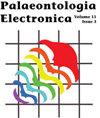同步辐射计算机断层扫描揭示始新世森林中苍蝇幼虫的生态系统功能
IF 1.5
4区 地球科学
Q1 Earth and Planetary Sciences
引用次数: 7
摘要
我们报道了始新世波罗的海琥珀中蝇幼虫(直翅目)的前所未有的多样性,并利用它们来解决周围森林中的古生态系统功能和过程。蝇幼虫被研究界认为异常罕见,与大多数昆虫幼虫一样,由于鉴定方面的挑战,蝇幼虫的效用有限。然而,在本文中,使用同步x射线辐射CT(SR-μCT)使我们能够检测和识别波罗的海琥珀中的数十只苍蝇幼虫,并推断它们的生态相互作用。其中一块琥珀含有56只苍蝇幼虫和明显的哺乳动物粪便。这个化石对我们理解始新世森林中的碳循环非常有意义。粪便残骸上出现如此大量的苍蝇幼虫表明,苍蝇在始新世森林中回收有机物方面发挥着重要作用,就像今天的一些幼虫一样。对苍蝇古群落的分析也使我们能够假设在波罗的海地区形成大规模地质相关琥珀矿床的机制。扫描使我们能够识别出七种与现存的Syrphide密切相关的幼虫,Syrphidae的幼虫栖息在真社会膜翅目的巢穴中,或者有时,从被其他穴居昆虫幼虫破坏的树上滴落的树液流中。Viktor A.Baranov。生物学II,慕尼黑路德维希·马克西米利安大学,普兰格,德国拜仁。通讯作者。baranow@biologie.uni-muenchen.de迈克尔·S·恩格尔。自然科学与数学生态学与进化生物学,堪萨斯大学生物多样性研究所,美国堪萨斯州。msengel@ku.edu约格·哈梅尔。材料研究所,德国Geesthacht,Helmholtz Zentrum Geesthacht。joerg.hammel@hzg.deMarie K.Hörnig。格雷夫斯瓦尔德大学,动物研究所和博物馆,细胞学和进化生物学,格雷夫斯瓦德,德国。marie.hoernig@palaeo-evo-devo.info托马斯·范德坎普。卡尔斯鲁厄理工学院光子科学与同步辐射研究所(IPS),赫尔曼·冯·亥姆霍兹平台1,76344 Eggenstein Leopoldshafen,德国和BARANO等人:在弹道AMBER中的幼虫2同步辐射应用实验室(LAS),卡尔斯鲁厄理工学院(KIT),凯撒。176131Karlsruhe,德国。thomas.vandekamp@kit.edu马库斯·祖伯。光子科学与同步辐射研究所(IPS),卡尔斯鲁厄理工学院(KIT),赫尔曼·冯·亥姆霍兹广场1,76344埃根斯坦-利奥波德沙芬,德国和同步辐射应用实验室(LAS),卡尔斯鲁厄理学院(KIT),凯撒。176131Karlsruhe,德国。marcus.zuber@kit.eduJoachim T.Haug。慕尼黑路德维希·马克西米利安大学生物学II,德国拜仁Planegg和慕尼黑路德维希·马克西米利安大学Geobio中心。jhaug@biologie.uni-muenchen.de本文章由计算机程序翻译,如有差异,请以英文原文为准。
Synchrotron-radiation computed tomography uncovers ecosystem functions of fly larvae in an Eocene forest
We report a hitherto unprecedented diversity of fly larvae (Diptera) from Eocene Baltic amber and the use of these to address palaeo-ecosystem functions and processes in the surrounding forests. Fly larvae have been considered exceptionally rare by the research community and have, like most insect larvae, been deemed of limited utility owing to challenges in identification. Herein, however, using synchrotron-x-ray radiation CT (SR-μCT) allowed us to detect and identify dozens of fly larvae from Baltic amber, and to infer their ecological interactions. One particular piece of amber contains 56 fly larvae and apparent mammalian feces. This fossil is of great interest for our understanding of carbon cycling in the Eocene forest. The occurrence of such a large number of fly larvae on the fecal remains indicates an important role of flies in recycling organic matter in the Eocene forest, much as some larvae do today. Analysis of the fly palaeo-communities also allowed us to hypothesize a mechanism by which massive, geologically relevant deposits of amber were formed in the Baltic region. Scanning allowed us to identify seven larvae closely related to the extant Syrphidae, whose larvae inhabit nests of eusocial Hymenoptera, or, sometimes, flows of sap dripping from trees damaged by other burrowing insect larvae. Viktor A. Baranov. Biology II, Ludwig-Maximilians-Universität München, Planegg, Bayern, Germany. Correspondence author. baranow@biologie.uni-muenchen.de Michael S. Engel. Natural Sciences and Mathematics Ecology & Evolutionary Biology, KU Biodiversity Institute, Kansas, USA. msengel@ku.edu Jörg Hammel. Institute of Materials Research, Helmholtz-Zentrum Geesthacht, Geesthacht, Germany. joerg.hammel@hzg.de Marie K. Hörnig. University of Greifswald, Zoological Institute and Museum,Cytology and Evolutionary Biology, Greifswald, Germany. marie.hoernig@palaeo-evo-devo.info Thomas van de Kamp. Institute for Photon Science and Synchrotron Radiation (IPS), Karlsruhe Institute of Technology (KIT), Hermann-von-Helmholtz-Platz 1, 76344 Eggenstein-Leopoldshafen, Germany and BARANOV ET AL.: DIPTERA LARVAE IN BALTIC AMBER 2 Laboratory for Applications of Synchrotron Radiation (LAS), Karlsruhe Institute of Technology (KIT), Kaiserstr. 1, 76131 Karlsruhe, Germany. thomas.vandekamp@kit.edu Marcus Zuber. Institute for Photon Science and Synchrotron Radiation (IPS), Karlsruhe Institute of Technology (KIT), Hermann-von-Helmholtz-Platz 1, 76344 Eggenstein-Leopoldshafen, Germany and Laboratory for Applications of Synchrotron Radiation (LAS), Karlsruhe Institute of Technology (KIT), Kaiserstr. 1, 76131 Karlsruhe, Germany. marcus.zuber@kit.edu Joachim T. Haug. Biology II, Ludwig-Maximilians-Universität München, Planegg, Bayern, Germany and Geobio-Center, Ludwig-Maximilians-Universität München, München, Bayern, Germany. jhaug@biologie.uni-muenchen.de
求助全文
通过发布文献求助,成功后即可免费获取论文全文。
去求助
来源期刊

Palaeontologia Electronica
地学-古生物学
CiteScore
3.60
自引率
0.00%
发文量
20
审稿时长
>12 weeks
期刊介绍:
Founded in 1997, Palaeontologia Electronica (PE) is the longest running open-access, peer-reviewed electronic journal and covers all aspects of palaeontology. PE uses an external double-blind peer review system for all manuscripts. Copyright of scientific papers is held by one of the three sponsoring professional societies at the author''s choice. Reviews, commentaries, and other material is placed in the public domain. PE papers comply with regulations for taxonomic nomenclature established in the International Code of Zoological Nomenclature and the International Code of Nomenclature for Algae, Fungi, and Plants.
 求助内容:
求助内容: 应助结果提醒方式:
应助结果提醒方式:


